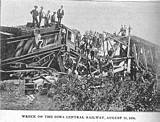
Wreck on the Iowa Central Railway, August 13, 1896
345
CHAPTER XXI
Railway Casualties
Early on the morning of July 13th, 1869, a
freight train, consisting of an engine and twelve freight cars, one baggage car,
one sleeper, and one passenger coach, in charge of Conductor H. S. Miller, of
Burlington, rumbled slowly down the grade west of Albia, on the C., B. & Q.
Railway. There had been a heavy rain that night, and Coal Creek was running out
of its banks.
Engineer Peter Ericsson and David Deffinbaugh,
fireman, sat in their places on the lookout for accidents. They had been warned
that the track was unsafe, and that large quantities of sand had been washed out
from under the piling of the bridge which spanned Coal Creek. The bridge was
made on pilings, and was about twenty feet high. When about the center of the
bridge, the engine went down with a crash, into the water, followed by seven of
the cars, after rising to the surface, floated slowly down the stream, turning
over and over in their passage, until they finally landed against trees.
The engineer and fireman were submerged with
their engine, and as the engine settled to the bottom of the stream, the men
climbed out through the window, and, coming to the surface, floated down with
the current and saved themselves.
When the train left Burlington, a man named Wm.
Herriott, with his four children, took passage in one of the ill fated cars.
They were en route to Taylor County, with a team an wagon, but at
Burlington concluded to ship on board the cars. Their wagon and team were taken
on board the train, and Mr. Herriott and children remained in the car with the
wagon. Their car was one that went down into the watery chasm. The father and
one little girl escaped from the car. The child, having crawled through the
partially opened side door, pried the door a little wider open and her father
was liberated, and in about an hour both were taken off the car and towed to dry
land by means of ropes.
346
The other three children were drowned, and
their bodies were not recovered until some hours later. The children's ages were
12, 11, 10, and 8, respectively. Emma, the oldest daughter, was the one who made
her escape, William, 12 years of age, together with his sisters aged 10 and 8,
respectively, were those who drowned.
A coroner's inquest fixed the blame for the
accident on the railroad company, and the company at once asked Mr. Herriott to
name the amount of damages. He named

Wreck on the Iowa Central Railway, August 13, 1896
$1,000 as the amount, which the company paid forthwith, and also tendered him $700 more, which was accepted. The company also paid all the expenses, making the total bill of $2,000. Mr. Herriott was well satisfied with this settlement, and the railway company was equally glad to escape with so small a sum. The corpses were taken back by friends to Bureau County, Illinois, for burial and the father and mother continued their journey to Taylor County, the latter having in the meantime joined her husband.
347
At this time Tom Potter, who afterwards
became General Superintendent of the Chicago, Burlington & Quincy Railway
system, was the station agent at Albia.
On the night of the 15th of August, 1896,
another casualty, quite similar to the foregoing, except that it was not
attended by loss of life, occurred on the Iowa Central Railroad, a short
distance west of the village of Hickory, Monroe County. A south bound passenger
train, due at Albia at 9:15 p. m., with McCarthy as conductor, Eads engineer,
and Shope fireman, in passing over the first bridge west of Hickory narrowly
escaped being precipitated into the stream. There had been a tremendous rain,
and the accumulation of drift washed against one of the piers had swept away one
of the bents of the bridge. The engine passed over this in some unaccountable
manner, but the baggage car began to settle. The engine was instantly detached,
and passed on over with her crew, en route to Albia. The next bridge
was 100 feet in length, and about 25 feet in height. It was a wooden structure
built on piling, and spanned Miller Creek, which at the time of the accident was
much swollen by the recent rain. The engine had no sooner gotten fairly on the
bridge than, without a moment's warning, it went down into the chasm with a
tremendous crash, alighting in five or six feet of water.
None of the crew were injured in the least
degree. The men climbed out of the cab, and passed along the side of the engine
until they caught hold of some projecting timbers, and drew themselves out of
the wreck. The engine sustained but slight injury, and within the next
forty eight hours an inclined track was built to it, when a huge Mogul engine
was harnessed to it by means of a long cable, and the engine was drawn out.
If
the train had passed safely over the first bridge, its fate at the second one
might have been terrible to contemplate.